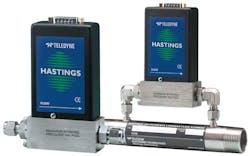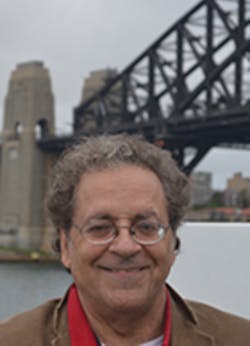How Mass Flow Controllers Are Making Their Mark In Industry
By Jesse Yoder, Ph.D.
Mass flow controllers (MFCs) are unique among flowmeters in that they not only measure the flow but also control it. Most MFCs include a control valve that is capable of modulating the flow, although some are shipped without the control function. It is because they have a control function that they are called flow controllers rather than flowmeters, even though they also measure the flow. This also explains why they are not always included in the total flowmeter market.
Most mass flow controllers employ a thermal principle. However, they are not considered to be thermal dispersion flowmeters, like the insertion meters that are used for flue stack and exhaust gas flow measurement. Instead, MFCs measure flow in small line sizes, usually 2" and less, and the large majority of them are used to measure gas flow. A small minority, however, are used to measure liquid flows.
MFCs operate by diverting the flow through a capillary tube. This tube gives them an inverted U appearance. Rather than measuring the entire flow as it passes through the meter body, a portion of the fluid is diverted through a capillary tube that travels in an inverted U path around the top of the meter. The flow is diverted by creating a small pressure drop in the flow line, which can be done by a laminar flow element. The fluid is measured as it passes through this small capillary tube, and then it rejoins the main flowstream.
READ ALSO: Flowmeter Calibration Lab Notes
To measure the flow at the top of the inverted U, two heated resistance temperature detectors (RTDs) are wrapped around the outside of the capillary tube. When there is no flow, both RTDs have the same signal. When fluid passes through the tube, a difference in temperature is created between the upstream and the downstream RTDs. This temperature difference is proportional to flowrate. The flowmeter senses this difference in temperature and uses it to create an output signal representing flow.
Source: The World Market Update for Mass Flow Controllers, published by Flow Research in July 2015.
Hastings Among the First to Introduce the Capillary Tube Design
The development of mass flow controllers is somewhat parallel to that of thermal dispersion flowmeters. In 1955, Hastings introduced a thermal air probe that placed small thermocouples in the flowstream. These thermocouples measured the rate of cooling. However, this device became covered with dirt and could not withstand the heat of the fluid, so it was withdrawn from the market.
Hastings made a more successful attempt in the early 1970s. By diverting the fluid through a capillary tube with temperature sensors on the outside, the company avoided the problems with its earlier design. This new design was more successful than the earlier one. Other companies were also working on mass flow controllers during the same period. Some sources credit Tylan General with introducing capillary tubes in the 1960s.
Mass Flow Controllers Have Evolved Since the Early Days
Mass flow controllers have evolved significantly since the early 1970s. In the 1980s, the semiconductor industry became the largest consumer of MFCs. In the 1990s, MFCs came to tolerate higher flowrates, and more ruggedized packaging was developed for industrial uses. In the early 2000s, digital bus protocols were introduced, along with MFCs that could measure multiple types of gases.
A number of new companies have entered the field in the past 30 years, though not all have survived. In the 1980s, Unit Instruments developed a line of MFCs aimed at the semiconductor market. Tylan General continued to be a force in the market. Other companies that became important in this market include Mykrolis, Millipore, Celerity, and Aera. In a major act of consolidation, Brooks Instrument acquired Celerity in 2009. This acquisition included all the MFCs that previously went under the names of Unit Instruments, Tylan, Mykrolis, Millipore, and Celerity. In 2010, Advance Energy Industries (AEI) sold its Aera MFC division to Hitachi Metals. Some of the leading companies today include Horiba STEC, Brooks Instrument, Hitachi Metals, and Bronkhorst.
Semiconductor Market–Dominant but Cyclical
Mass flow controllers are used in the semiconductor industry to measure and control many of the gases used in the semiconductor chip-making process. This includes chemical vapor deposition (CVD), plasma etching processes, backside water cooling, and many other applications in semiconductor manufacturing. The semiconductor industry accounts for more than 50 percent of the mass flow controllers sold worldwide. It is still the dominant application for mass flow controllers.
Industrial Markets Promise Steady Long-Term Growth for Mass Flow Controllers
Despite the dominance of the semiconductor industry, some MFC companies have brought out multiple products designed to address the industrial markets. One reason for this is the cyclical nature of the semiconductor industry. The semiconductor industry seems to be subject to peaks and valleys of production and demand, more so than many other industries. Furthermore, these cycles can be hard to predict. By diversifying into industrial markets, MFC companies help to insulate themselves from the ups and down nature of the semiconductor industry.
Some of the leading industrial applications for mass flow controllers include chemical/petrochemical, metals processing, gas analyzers, and solar/photovoltaic. Other important applications include biotech/pharmaceutical, fuel cells, LED lighting, and fiber optics/glass. Mass flow controllers are used in a wide variety of industrial manufacturing processes outside of the semiconductor industry, and these applications are providing greater stability for those companies that choose to address them.
Many applications on the industrial side involve renewable energy. These include fuel cells, LED lighting, and solar/photovoltaic, among others. These applications can also be subject to ups and downs, compared to applications in, for example, the chemical industry, which are more constant. There are several reasons for the fluctuations in the alternative energy applications. One is that many of them depend on how much research and development money is allocated to them. Even though most people would accept the idea that renewable energy is likely to win out as a long-term solution to the world’s energy needs, the enthusiasm and commitment to renewable energy varies with multiple factors.
When gas and oil prices are relatively low, as they are now, there is less short-term commitment to solar and hydrogen fuel as alternative energy sources. This can affect the demand for mass flow controllers in solar/photovoltaic and fuel cell applications. However, the United States, Germany, and other countries have made commitments to reduce dependence on fossil fuels and to rely on renewable energy sources increasingly over time. As a result, renewable energy applications will grow significantly over time, even if they experience short-term downturns. This is likely to benefit companies that invest in these industries.
Some of the companies that have invested significantly in industrial MFC markets include Brooks Instrument, Horiba STEC, and MKS (www.mksinst.com). While all these companies sell into the semiconductor market, they have also chosen to develop products for industrial markets. This is also true of a number of smaller MFC suppliers. Even though these companies will continue to service the semiconductor market, their presence in industrial markets gives them a hedge against the ups and downs of the semiconductor market. This decision to diversify is likely to be a plus for these companies over time.
Of course, not all industrial markets are equally promising. Any MFC company that wants to enter these markets should select those that fit in well with its product line and that also show promise of growth. The automotive and aerospace markets have gone through difficult times but are now recovering. The fuel cell and biotech/pharmaceutical markets show great promise. The chemical and food & beverage markets are likely to show moderate but steady growth over time. Power is an area that seems to always be expanding, as more countries industrialize and populations increase.
Emerging Markets Offer Continued Demand for Mass Flow Controllers
The economies of China, India, and other emerging markets in Asia and elsewhere are continuing to grow at a rapid pace. Even if these economies are affected by a slowdown, their continued population growth will result in growing demand in a variety of industrial segments including energy consumption, food & beverage, automotive, power, and other segments. China and India will also be a source for continued demand for computers and semiconductor products. All these forces will work toward increased use of mass flow controllers in the long term.
Flow Research published a market study called The World Market Update for Mass Flow Controllers in July 2015. For more information, visit www.flowmfc.com.
Jesse Yoder, Ph.D.
Jesse Yoder, Ph.D., is president of Flow Research Inc. in Wakefield, Massachusetts, a company he founded in 1998. He has 28 years of experience as an analyst and writer in instrumentation. He holds a US patent on a dual tube flowmeter design, and is the author of The Tao of Measurement, published by ISA. Dr. Yoder can be reached at [email protected].
About the Author
Jesse Yoder
Jesse Yoder, Ph.D., is president of Flow Research Inc. He has 30 years of experience as an analyst and writer in instrumentation. Yoder holds two U.S. patents on a dual-tube meter design and is the author of "The Tao of Measurement," published by ISA. He may be reached at [email protected]. Find more information on the latest study from Flow Research, "The World Market for Gas Flow Measurement, 4th Edition," at www.gasflows.com.

